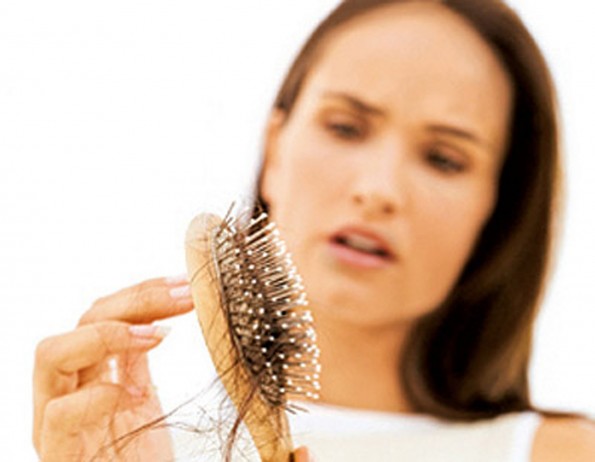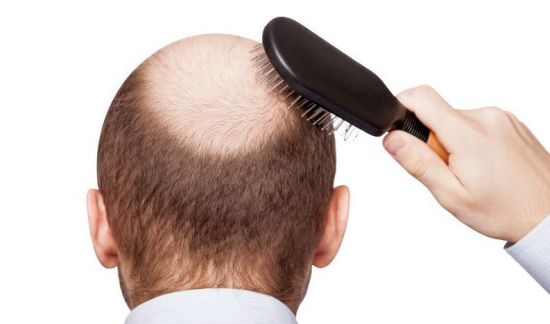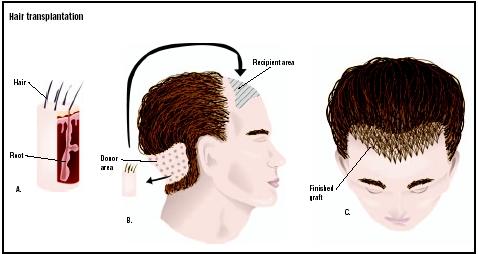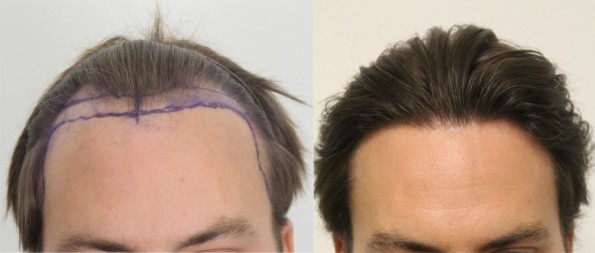 What Is Hair Loss?
What Is Hair Loss?
Hair grows everywhere on the human skin except on the palms of our hands and the soles of our feet, but many hairs are so fine they’re virtually invisible. Hair is made up of a protein called keratin that is produced in hair follicles in the outer layer of skin. As follicles produce new hair cells, old cells are being pushed out through the surface of the skin at the rate of about six inches a year. The hair you can see is actually a string of dead keratin cells. The average adult head has about 100,000 to 150,000 hairs and loses up to 100 of them a day; finding a few stray hairs on your hairbrush is not necessarily cause for alarm.
At any one time, about 90% of the hair on a person’s scalp is growing. Each follicle has its own life cycle that can be influenced by age, disease, and a wide variety of other factors. This life cycle is divided into three phases:
- Anagen — active hair growth that lasts between two to six years
- Catagen — transitional hair growth that lasts two to three weeks
- Telogen — resting phase that lasts about two to three months; at the end of the resting phase the hair is shed and a new hair replaces it and the growing cycle starts again.
As people age, their rate of hair growth slows.
There are many types of hair loss, also called alopecia:
- Involutional alopecia is a natural condition in which the hair gradually thins with age. More hair follicles go into the resting phase, and the remaining hairs become shorter and fewer in number.
- Androgenic alopecia is a genetic condition that can affect both men and women. Men with this condition, called male pattern baldness, can begin suffering hair loss as early as their teens or early 20s. It’s characterized by a receding hairline and gradual disappearance of hair from the crown and frontal scalp. Women with this condition, called female pattern baldness, don’t experience noticeable thinning until their 40s or later. Women experience a general thinning over the entire scalp, with the most extensive hair loss at the crown.
- Alopecia areata often starts suddenly and causes patchy hair loss in children and young adults. This condition may result in complete baldness (alopecia totalis). But in about 90% of people with the condition, the hair returns within a few years.
- Alopecia universalis causes all body hair to fall out, including the eyebrows, eyelashes, and pubic hair.
- Trichotillomania , seen most frequently in children, is a psychological disorder in which a person pulls out one’s own hair.
- Telogen effluvium is temporary hair thinning over the scalp that occurs because of changes in the growth cycle of hair. A large number of hairs enter the resting phase at the same time, causing hair shedding and subsequent thinning.
- Scarring alopecias result in permanent loss of hair. Inflammatory skin conditions (cellulitis, folliculitis, acne), and other skin disorders (such as some forms of lupus and lichen planus) often result in scars that destroy the ability of the hair to regenerate. Hot combs and hair too tightly woven and pulled can also result in permanent hair loss.

What Causes Hair Loss?
Doctors don’t know why certain hair follicles are programmed to have a shorter growth period than others. However, several factors may influence hair loss:
Hormones, such as abnormal levels of androgens (male hormones normally produced by both men and women)
Genes, from both male and female parents, may influence a person’s predisposition to male or female pattern baldness.
Stress, illness, and childbirthcan cause temporary hair loss. Ringworm caused by a fungal infection can also cause hair loss.
Drugs, including chemotherapy drugs used in cancer treatment, blood thinners, beta-adrenergic blockers used to control blood pressure, and birth control pills, can cause temporary hair loss.
Burns, injuries, and X-rays can cause temporary hair loss. In such cases, normal hair growth usually returns once the injury heals unless a scar is produced. Then, hair will never regrow.
Autoimmune disease may cause alopecia areata. In alopecia areata, the immune system revs up for unknown reasons and affects the hair follicles. In most people with alopecia areata, the hair grows back, although it may temporarily be very fine and possibly a lighter color before normal coloration and thickness return.
Cosmetic procedures, such as shampooing too often, perms, bleaching, and dyeing hair can contribute to overall hair thinning by making hair weak and brittle. Tight braiding, using rollers or hot curlers, and running hair picks through tight curls can also damage and break hair. However, these procedures don’t cause baldness. In most instances hair grows back normally if the source of the problem is removed. Still, severe damage to the hair or scalp sometimes causes permanent bald patches.
Medical conditions. Thyroid disease, lupus, diabetes, iron deficiency, eating disorders, and anemia can cause hair loss. Most times, when the underlying condition is treated, the hair will return unless there is scarring as in some forms of lupus, lichen planus or follicular disorders.
Diet. A low-protein diet or severely calorie-restricted diet can also cause temporary hair loss.

What Is a Hair Transplant?
It’s a type of surgery that moves hair you already have to fill an area with thin or no hair. Doctors have been doing these transplants in the U.S. since the 1950s, but techniques have changed a lot in recent years.
Next, the surgeon’s team divides the strip of removed scalp into 500 to 2,000 tiny grafts, each with an individual hair or just a few hairs. The number and type of graft you get depends on your hair type, quality, color and the size of the area where you’re getting the transplant.
If you’re getting the FUE procedure, the surgeon’s team will shave the back of your scalp. Then, the doctor will remove hair follicles one by one from there. The area heals with small dots, which your existing hair will cover.
After that point, both procedures are the same. After he prepares the grafts, the surgeon cleans and numbs the area where the hair will go, creates holes or slits with a scalpel or needle, and delicately places each graft in one of the holes. He’ll probably get help from other team members to plant the grafts, too.
Depending on the size of the transplant you’re getting, the process will take about 4 to 8 hours. You might need another procedure later on if you continue to lose hair or decide you want thicker hair.
Expectations and Recovery
After the surgery, your scalp may be very tender. You may need to take pain medications for several days. Your surgeon will have you wear bandages over your scalp for at least a day or two. He may also prescribe an antibiotic or an anti-inflammatory drug for you to take for several days. Most people are able to return to work 2 to 5 days after the operation.
Within 2 to 3 weeks after surgery, the transplanted hair will fall out, but you should start to notice new growth within a few months. Most people will see 60% of new hair growth after 6 to 9 months. Some surgeons prescribe the hair-growing drug minoxidil (Rogaine) to improve hair growth after transplantation, but it’s not clear how well it works.
Risks and Costs of Treatment
The price of a hair transplant will depend largely on the amount of hair you’re moving, but it generally ranges from $4,000 to $15,000. Most insurance plans don’t cover it.
As with any kind of surgery, transplants have some risks, including bleeding and infection. There’s also the chance for scarring and unnatural-looking new hair growth.
Around the time new locks start to grow, some people have inflammation or an infection of the hair follicles, called folliculitis. Antibiotics and compresses can relieve the problem. It’s also possible to suddenly lose some of the original hair in the area where you got the new strands, called shock loss. But most of the time, it’s not permanent.
Talk with your doctor about these risks and how much improvement you’re likely to get from the surgery. He can help you decide if it’s a good option for you.


0 comments on “Hair Transplants”Add yours →